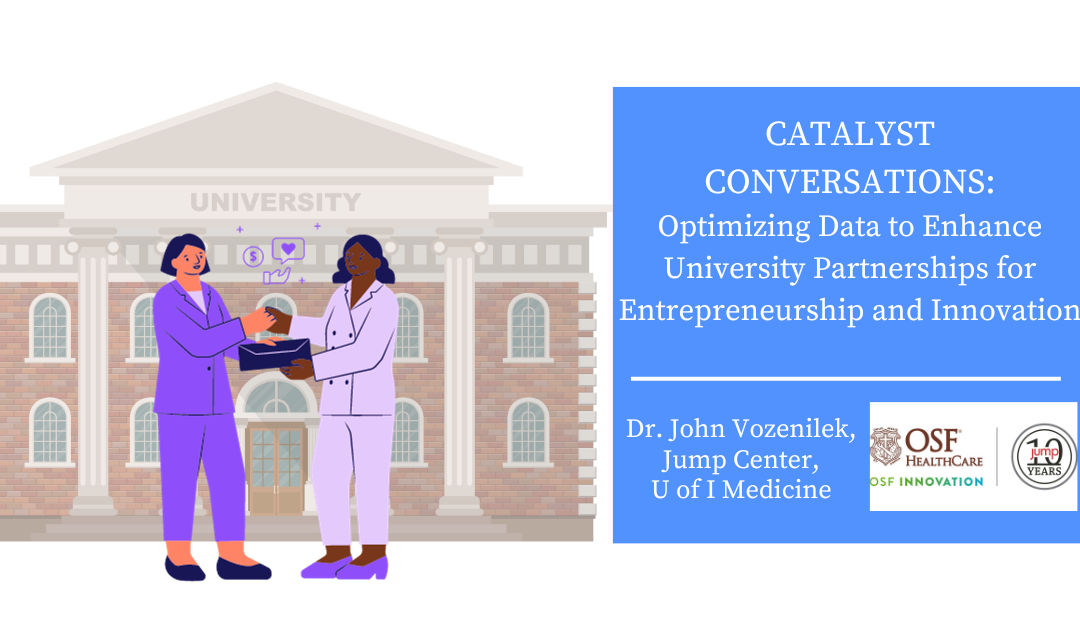CATALYST CONVERSATIONS: Optimizing Data to Enhance University Partnerships for Entrepreneurship and Innovation
Illinois boasts a diverse and dynamic innovation ecosystem that spans industries such as technology, healthcare, finance, agriculture, and manufacturing. With renowned institutions and cutting-edge research centers, the state provides fertile ground for groundbreaking ideas to take root. However, the true potential of this ecosystem can only be unlocked with the aid of data-driven insights.
Data insights act as a unifying force within Illinois’ innovation ecosystem. They facilitate collaboration between startups, corporations, academia, and government agencies. By sharing data and insights, stakeholders can identify synergies, pool resources, and collectively address complex challenges that transcend individual capacities.
We spoke with Dr. John Vozenilek, who is uniquely postioned at the intersection of university and corporate partnership as Chief Medical Officer of the Jump Trading Simulation and Education Center and the Duane and Mary Cullinan Endowed Professor for Simulation Outcomes at the University of Illinois College of Medicine, and who provided the keynote address for ISTC’s Illinois Innovation Index on University Entrepreneurship report preview in September. Under his direction, OSF Healthcare System and the University of Illinois College of Medicine at Peoria have created tremendous organizational capabilities and infrastructure, building resources for engineers and educators who wish to use innovative technologies for the improvement of clinical performance.
Dr. Vozenilek shared his insights on the importance of access to the distinctive data that the University Entrepreneurship report provides and the impact that partnerships with universities has on the greater innovation ecosystem and visa versa.
To read the full University Entrepreneurship report, click here.

Dr. John Vozenilek,
Chief Medical Officer of the Jump Trading Simulation and Education Center,
Duane and Mary Cullinan Endowed Professor for Simulation Outcomes at the University of Illinois College of Medicine
Can you tell us what kind of value you find as a practitioner in the unique data shared in the university entrepreneurship report?
As we evaluate the trends that come forward in this report, we actually can begin to steel ourselves for next year and prepare for the great opportunities that will come. Frankly, a lot of the work that we do is in mentoring these entrepreneurial ideas. For this report to give these university entrepreneurs a sense of what’s coming in the future, the resources that are available, and how they’re interconnected is crucial to their success. This data also helps us to understand the role of university based entrepreneurship, the paths forward for students and non-students alike to bring their ideas to life in our community. It’s an incredibly important document.
What do you think this report says about the value of partnerships and the Impact Overall towards innovation and entrepreneurship?
It’s clear that as a principle, we need to align the academic environment alongside a variety of industries in our area to encourage those academic influences to access opportunities and identify the problem statements that exist in healthcare, manufacturing, material science, and other emerging industries, allowing them to spark innovation. Those sparks become opportunities for investment and for entrepreneurship. And frankly, that’s part of the journey we’ve been on here at OSF Healthcare, which is to bring those academic viewpoints into play. We bring technology in from those university partners, and then we bring it into our clinical context to create new intellectual property and to change the lives of the patients we serve.
What advice can you offer to emerging entrepreneurs as they build their strategic growth plans?
As I encounter these wonderful ideas, one of the main features that I think people need to come to understand is there are a variety of resources available. I learned from our ecosystem partners about the diversity of supporting structures that lead to positive entrepreneurship for Illinois. I love the statistics that demonstrate that there’s value in that partnering and knowing that those resources cause people to want to stay in Illinois, and in particular, here in Central Illinois. We love to see the growth of businesses for our communities.
What is your biggest takeway from the University entreprenership report that you believe is important to supporting sustainable growth?
In what ways do you feel that the partnerships between university entrepreneurs and corporate partners can help these new ventures scale their efforts?
Here at the Jump Center, we’ve invested heavily in virtual reality and augmented reality as tools to help us understand environments, devices at scales that are not limited by physical bricks and mortar encounters. So we want to give our university entrepreneurs the ability to think about how could they demonstrate if they were going to do a pitch deck of the future. Could they incorporate augmented reality into their pitch? Can they bring in 3D modeling? Could they do their pitch in virtual reality or the metaverse? How would that change the way that pitches happen and the connectivity to VCs that are perhaps as far away as the east or West Coast and bring value to ideas here in Central Illinois? Now, of course, we’d love to see those ideas stay in Illinois, but think about the scale of being able to pull ideas in and to really support them across the entire state.
HOw do you feel that partners, specifically osf innovation, are moving the needle forward in optimizing relationships with university entrepreneurs?
I think that here at OSF innovation in particular, the academic partnerships, like we have with Illinois State University, University of Illinois, both in Chicago and in Urbana and our partners here at Bradley University are incredibly valuable and mutually beneficial. What we’re really doing is mentoring good ideas and we’re providing the fuel to expand their ideas beyond their current means. We engage with innovators from engineering and material science to computer science, to social work and a myriad of industries across these universities to really bring new ideas into context with healthcare.
I think at its core, there’s an idea here where anchor institutions participate in the benefit of their community. So anchor institutions may be banks and other organizations of that type, but certainly hospitals where healthcare comes to pass, and of course, academia, where people get education, are two anchor institutions. When those anchor institutions are combined in their effots for the benefit of their communities, there’s real value there.

